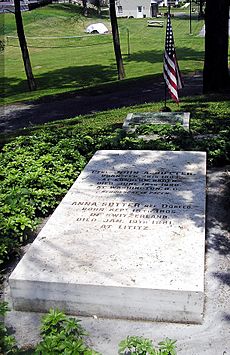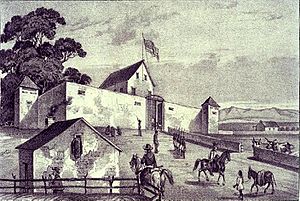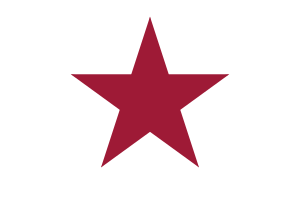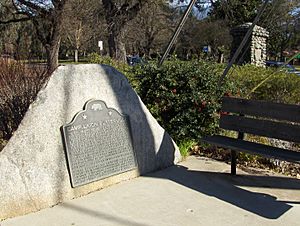John Sutter facts for kids
Quick facts for kids
John Sutter
|
|
|---|---|

John Sutter, c. 1850
|
|
| Born |
Johann August Suter
February 23, 1803 Kandern, Margraviate of Baden, Holy Roman Empire
|
| Died | June 18, 1880 (aged 77) |
| Spouse(s) | Annette D'beld |
| Children | 5, including John Augustus Sutter Jr. |
John Augustus Sutter (born February 23, 1803 – died June 18, 1880) was originally named Johann August Sutter. He was a Swiss immigrant who became a citizen of Mexico and later the United States. He is famous for building Sutter's Fort in what is now Sacramento, California, the state's capital city.
Even though his employee, James W. Marshall, discovered gold at Sutter's Mill, Sutter's own businesses struggled during the California Gold Rush. However, his older son, John Augustus Sutter Jr., had more success with his ventures.
Early Life and Journey to America
Johann August Sutter was born on February 23, 1803, in Kandern, which is in present-day Germany. His father worked at a paper mill.
Sutter went to school in Kandern and later studied in Saint-Blaise, Switzerland. He then worked as an apprentice at a printing house and as a clerk in clothing shops. When he was 21, he married the daughter of a wealthy widow. He ran a store, but he spent more money than he earned. Because he had many debts, he decided to leave for America. He started calling himself Captain John Augustus Sutter.
In May 1834, he left his family in Burgdorf, Switzerland. He traveled by ship from France to New York City, arriving on July 14, 1834.
Adventures in the New World
In North America, John Augustus Sutter traveled a lot. He already knew Spanish and English, along with Swiss French. He and a group of Germans moved from the St. Louis area to Santa Fe, New Mexico, which was then part of Mexico. Later, he moved to Westport, now part of Kansas City, Missouri.
In 1838, he joined a group of missionaries and fur trappers. They traveled the Oregon Trail to Fort Vancouver in Oregon Territory. From there, Sutter sailed to the Kingdom of Hawaii. He stayed in Hawaii for four months and became friends with important officials and merchants.
Sutter then hired a ship to take supplies to Sitka, Alaska, which was the capital of the Russian colonies in North America. After a month in Sitka, Sutter sailed to Alta California, arriving on July 1, 1839, in Yerba Buena, California (now San Francisco, California). At that time, Yerba Buena was just a small port town.
Building Sutter's Fort
When Sutter arrived, Alta California was a province of Mexico. Sutter had to go to the capital in Monterey to get permission from the governor, Juan Bautista Alvarado, to settle there. Governor Alvarado thought Sutter's idea of building a colony in the Central Valley would help protect the area from Native Americans, Russians, Americans, and the British.
Sutter convinced Governor Alvarado to give him about 48,400 acres of land. This land was called New Helvetia, meaning "New Switzerland." Sutter was given the power to enforce laws and act as a judge to stop robberies and protect against Native American groups and traders.
To get the land, Sutter had to live in the territory for a year and become a Mexican citizen, which he did in August 1840. However, after he got his land and built his fort, Sutter did not keep his promise to discourage other Europeans from settling there. Instead, he helped more Europeans come to California.
Construction of a fortified settlement began in August 1839. Sutter named it New Helvetia. To gain respect, Sutter pretended to be a Swiss guard officer. The settlement was finished in 1841. On June 18, he officially received the title to his land, which is now part of Sacramento, California.
Life at Sutter's Fort and Native American Relations
Sutter's Fort had a main building made of adobe bricks. It was surrounded by a high wall with towers at the corners for protection. The fort also had workshops and stores that made everything needed for the New Helvetia settlement.
Sutter employed or used Native Americans from the Miwok and Maidu tribes, as well as Hawaiians he had brought with him. He also had some Europeans working at his fort. He dreamed of creating a large farming community, and for a while, the settlement was very successful. Before the Gold Rush, it was a common stop for most immigrants entering California, including the Donner Party in 1846, whom Sutter helped rescue.
To build his fort and develop his large ranching and farming operations, Sutter relied on Native American labor. Some Native Americans worked for Sutter willingly, but others were forced to work in ways that were similar to slavery. Sutter believed that Native Americans needed to be kept "under fear" to serve white landowners.
Living and working conditions at the fort were very difficult for many Native Americans. They often slept on bare floors in locked rooms without proper sanitation and ate from shared troughs. If Native Americans refused to work, Sutter sometimes used violence.
Despite his promises to the Mexican government, Sutter welcomed American settlers into the region. These settlers took large amounts of land from Native Americans, which had been important for their food and resources. As white settlers raised livestock, hunted wild game, and turned wilderness into farms, the food available for Native Americans decreased. Some Native Americans then raided the cattle of white ranchers. In response, there were attacks on Native American villages.
After California became part of the United States, new laws were passed that made it legal for white settlers to force Native Americans into labor. In 1851, California's governor stated that a "war of extermination" would continue until the Native American population was gone. The state even allowed settlers to claim money from the government for their expenses in killing Native Americans.
In 1860, a law was passed that expanded the forced labor of Native Americans. Some people accused wealthy individuals of pushing for this law to profit from enslaved Native Americans.
Revolts and Changes in Power
The Lone Star Rebellion
In 1844–1845, there was a revolt in the Mexican colony of California against the Mexican army. Two years earlier, in 1842, Mexico had replaced California Governor Juan Bautista Alvarado with Brigadier General Manuel Micheltorena and sent an army.
This army was made up of soldiers who often stole from Californians. People complained that the army was committing robberies and beatings. In late 1844, the Californians revolted against Micheltorena.
Micheltorena had appointed Sutter as a military commander. Sutter gathered men, including John Marsh, a doctor and ranch owner. Marsh sided with the Californians and did not want to fight for Micheltorena. However, Sutter gave Marsh a choice: join the army or go to jail.
In 1845, Sutter's forces met the Californian forces at the Battle of Providencia. This battle mostly involved cannons. During the fight, Marsh secretly talked with the other side. Many Americans were fighting on both sides. Marsh convinced the Americans that they should not be fighting each other.
The Americans agreed and stopped fighting. As a result, Sutter's forces lost the battle. Micheltorena and his army returned to Mexico, and Californian Pio Pico became governor.
Mexico Loses California
Mexico's control over California became very weak during the Mexican American War. Sutter, who claimed to be a citizen of France, threatened to gather British, Canadian, and American immigrants and Native Americans to declare New Helvetia an independent republic under French protection.
On July 7, 1846, after the Bear Flag Revolt, a U.S. naval captain named John B. Montgomery raised the American flag in Monterey. Montgomery sent an American flag to Sutter, who raised it at his fort on July 11, 1846. This marked the formal change of his fort to U.S. command. Sutter was later made a lieutenant in the U.S. Army. Command of the fort returned to Sutter the next year.
The California Gold Rush Begins
In 1848, gold was discovered in the area. One of Sutter's most trusted employees, James W. Marshall, found gold at Sutter's Mill. Sutter had hired Marshall to build a sawmill powered by water in Coloma, California, along the American River. Sutter wanted to build a city on his land, including houses and a dock, and needed lumber for construction.
One morning, as Marshall checked the mill's water channel, he noticed some gold nuggets. He showed them to Sutter. Together, they read about gold and did simple tests to confirm it was real. Sutter realized it was gold, but he was worried the discovery would ruin his plans for building and farming. At the same time, he tried to get legal ownership of as much land near the discovery as possible.
Sutter's attempt to keep the gold discovery a secret failed. A merchant and newspaper publisher named Samuel Brannan returned from Sutter's Mill to San Francisco with gold and started telling everyone about the find. Soon, huge crowds of people rushed to the land, destroying almost everything Sutter had worked for. To avoid losing everything, Sutter gave his remaining land to his son, John Augustus Sutter Jr..
When Sutter's oldest son arrived from Switzerland, Sutter Sr. asked his friend Heinrich Lienhard to lend him his share of the gold he had mined. Sutter wanted to impress his son with a large amount of gold. However, when Lienhard later went to the Fort, Sutter Jr. had taken over his father's businesses, which were in debt. Sutter Jr. could not return Lienhard's share of the gold. Lienhard eventually accepted Sutter's sheep as payment.
The younger Sutter, who arrived in September 1848, saw the business opportunities in the land. He quickly started plans for building a new town he named Sacramento, California, after the Sacramento River. The elder Sutter did not like this; he wanted the town named Sutterville and built closer to New Helvetia.
Sutter eventually gave up New Helvetia to pay off his remaining debts. He rejoined his family and lived at Sutter Hock Farm in California. In 1853, the California legislature made Sutter a Major General in the state militia.
Later Life and Legacy
Sutter's land grant, called El Sobrante, was challenged by a group of squatters. In 1858, the U.S. Supreme Court ruled that his land grant was not valid.
After his Hock Farm was destroyed by fire in 1865, Sutter moved to Washington D.C. He had a letter of introduction to the U.S. Congress from the governor of California.
Sutter tried to get money back for the losses he suffered because of the Gold Rush. He received a pension of $250 a month as a refund for taxes he had paid on the Sobrante land. In 1871, he and his wife Annette moved to Lititz, Pennsylvania. They chose Lititz because it was close to Washington, D.C., and because of its famous healing springs. He also wanted his grandchildren to attend the good private Moravian Schools there.
John Sutter spent the rest of his life trying to get the government to pay him for his losses, but he was not successful. On June 16, 1880, Congress ended its session without passing a bill that would have given Sutter $50,000. Two days later, on June 18, 1880, Sutter died in Washington D.C. He was buried in Lititz, Pennsylvania, next to the Moravian Graveyard. His wife, Anna Sutter, died the following January and is buried with him.
Sutter's Legacy

Many places in California are named after John Sutter. Sutter Street in San Francisco, Sutter's Landing, Sutterville Road, Sutter Middle School, Sutter's Mill School, and Sutterville Elementary School in Sacramento are all named for him. The Sutterville Bend of the Sacramento River is also named after Sutter, as is Sutter Health, a healthcare system in Northern California. The cities of Sutter Creek, California and Sutter, California also bear his name.
In Acapulco, Mexico, the property that belonged to John Augustus Sutter Jr. became the Hotel Sutter, which is still open today. The Sutter Buttes, a mountain range near Yuba City, California, and Sutter County, California (where Yuba City is located) are also named after him.
The 'Sutter's Gold' rose, a type of orange-colored rose, was named after him.
California Governor Jerry Brown had a Welsh corgi dog named Sutter Brown, who was often called the First Dog of California. Sutter the dog died in late 2016 from cancer.
On June 15, 2020, during the Black Lives Matter protests, a statue of John Sutter outside the Sutter Medical Center in Sacramento, CA, was removed. This was done out of respect for some community members' feelings and for the safety of patients and staff.
Popular Culture
Films
- Days of '49 (1924, serial), with Charles Brinley as Sutter
- California in '49 (1924), with Charles Brinley as Sutter
- The Kaiser of California (1936), with Luis Trenker as Sutter
- Sutter's Gold (1936), with Edward Arnold as Sutter
- Kit Carson (1940), with Edwin Maxwell as Sutter
- "The Pathfinder" (The Great Adventure, 1964), with Carroll O'Connor as Sutter
- Fortune (1969), with Pierre Michael as Sutter
- Donner Pass: The Road to Survival (1978), with Royal Dano as Sutter
- The Chisholms, CBS miniseries, role of Sutter played by Ben Piazza (1980)
- California Gold Rush (1981), with John Dehner as Sutter
- Dream West (1986), with Jerry Orbach as Sutter
- General Sutter (1999), with Hannes Schmidhauser as Sutter
Comics
- Tex Willer Special#9: La Valle del Terrore (1996) by Claudio Nizzi and Magnus
Music
- "Sutter's Mill", a song by Dan Fogelberg (1985)
Literature
- L'Or, a novel by Blaise Cendrars (1925). This book describes his life as more sad than it actually was.
- Stefan Zweig tells Sutter's story in one of his Sternstunden der Menschheit (1927) called Die Entdeckung Eldorados ("The Discovery of Eldorado").
- Luis Trenker Der Kaiser von Kalifornien, 1961 novel based on his 1936 screenplay, which was inspired by L'Or.
- "John Sutter", a poem by Yvor Winters (1960).
See also
 In Spanish: John Sutter para niños
In Spanish: John Sutter para niños









